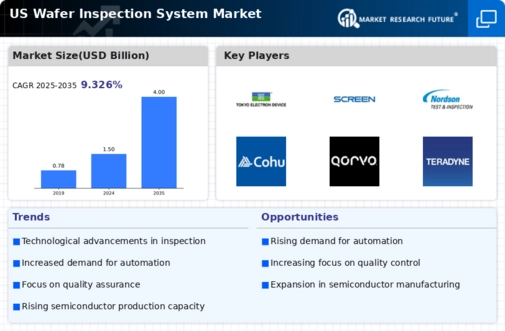The competitive landscape of the US Wafer Inspection System Market is characterized by various factors, including technological advancements, market demand, and the presence of key players who drive innovation and quality. As semiconductor manufacturing continues to evolve, the need for advanced inspection systems becomes increasingly critical in ensuring the production of high-quality wafers. Companies participating in this market are engaged in constant research and development efforts to enhance their offerings, further strengthening their positions.
The market is underscored by a diverse range of inspection technologies that cater to different stages of the semiconductor manufacturing process, thereby making competition intense as firms strive to meet the specific demands of manufacturers. With the integration of artificial intelligence and machine learning, inspection systems are becoming more efficient, prompting companies to strategically align their products with emerging technological trends while maintaining a keen eye on cost-control measures. In the US Wafer Inspection System Market, Tokyo Electron has established itself as a formidable player. The company’s strengths lie in its extensive experience and deep-rooted expertise in semiconductor manufacturing equipment.
Tokyo Electron has developed a strong brand reputation built on reliability and performance, which resonates with customers looking for precision and efficiency in their manufacturing processes.
The company's focus on innovation is evident through its ongoing investments in research and development, aimed at enhancing the capabilities of its wafer inspection systems. Moreover, Tokyo Electron has a robust service network across the United States, allowing it to provide comprehensive support and maintenance solutions, which further solidifies its market presence. This commitment to customer service, along with the effective scalability of its products, positions Tokyo Electron favorably within the competitive matrix of the US market.ASML Holding has made significant strides within the US Wafer Inspection System Market, particularly with its flagship products that are pivotal in advanced photolithography.
Known for its cutting-edge Extreme Ultraviolet (EUV) lithography systems, ASML also offers comprehensive inspection tools that are integral in the wafer manufacturing process. The company has cultivated a strong foothold in the US market through strategic partnerships and collaborations with leading semiconductor manufacturers. ASML’s strengths include its innovative technology and a commitment to maintaining high standards of precision in semiconductor production.
The company has continuously focused on mergers and acquisitions to bolster its technological capabilities and extend its market reach. By integrating complementary technologies and enhancing production efficiencies through these strategic moves, ASML has reinforced its competitive positioning in the US Wafer Inspection System Market, ensuring that it remains at the forefront of the industry’s evolution.
















